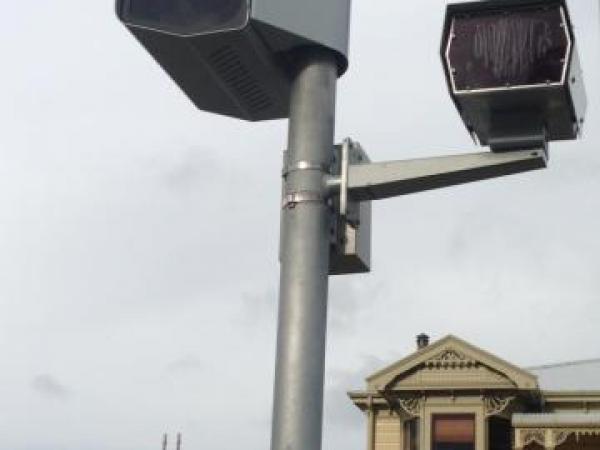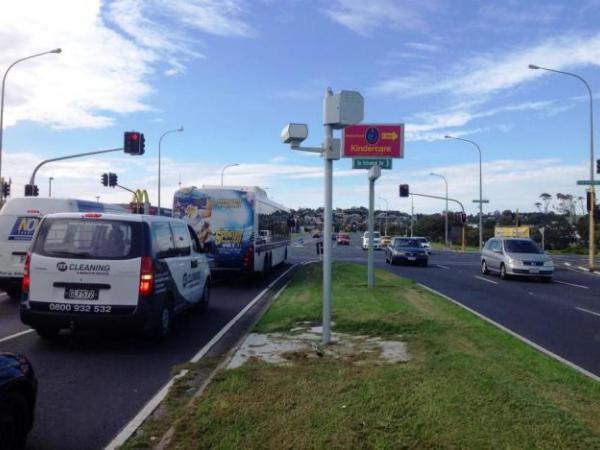New Police red-light cameras are scheduled to go live at three high-risk intersections from 8am on Thursday 30 April.
The new-generation cameras use radar technology to detect red light runners. It’s the first time the technology has been used in New Zealand.
Assistant Commissioner Road Policing, Dave Cliff, says the cameras – two in Auckland and one in Wellington – will help to improve safety at the selected intersections, which have a history of red-light crashes.
"Overseas, red-light cameras have been associated with significant reductions in injury crashes. Our goal is to achieve the same at these high-risk intersections, as it is for the road controlling authorities in Auckland and Wellington that have worked in partnership with us on this project."
The cameras have been installed at signalised intersections identified as high risk for red light crashes through robust NZ Transport Agency analysis. Police and the relevant road controlling authorities considered factors including the analysis, crash history and suitability of the intersection layout.
The intersections are: Karo Drive and Victoria Street in Wellington; Te Irirangi and Tī Rakau drives in Botany; and the Lambie Drive Interchange (east-bound off-ramp), Manukau.
Mr Cliff says the dual-function speed and red light cameras will operate in red light mode only for the time being, though the speed camera capability offers future potential to also detect those driving through the intersection at unsafe speeds once processing systems have been upgraded.
"The cameras have been operating in trial mode for the last three months to make sure the new technology works perfectly before being switched to enforcement mode.
“Red-light running is highly dangerous – it risks the lives of others simply to get a few metres further along the road. Police's goal is to help improve safety at these high risk intersections, which collectively have seen 43 injury crashes occur over the last few years – 31 of which were directly linked to red light running."
The camera system uses radars to track and capture vehicles running the red light. The primary radar scans and tracks vehicles as they approach the intersection. If a vehicle crosses the stop line during a red-light phase, a camera photographs the rear of the vehicle. A second radar (known as the validation radar) ensures the photograph taken is of the breaching vehicle.
The cameras are a joint project involving Police and three road controlling authorities: Auckland Transport, NZ Transport Agency (including the Auckland Motorway Alliance) and Wellington City Council.
Leo Mortimer, Ministry of Transport manager of Land Transport Safety, says, “The Ministry of Transport supports the introduction of the new red light cameras in Auckland and Wellington. The cameras will provide another useful tool to help prevent fatalities and serious injuries at intersections.”
Ernst Zollner, NZ Transport Agency Road Safety Director, said red light cameras would improve safety for drivers and for pedestrians at these busy intersections. “These cameras will send a clear message to the small minority of drivers who choose to run red lights that their actions put everyone else at risk, including children crossing on foot. It’s dangerous and unacceptable to hit the accelerator instead of the brakes when the light turns red.”
At this stage the roll-out is limited to the three cameras, with the funding, ownership and operation of any future red-light cameras yet to be determined.
Ministry of Transport data shows there were 280 fatal and 2,965 serious injury crashes at intersections from 2009-2013. Of those, 12 fatal crashes and 149 serious injury crashes were caused by a driver running a red or an amber light.
"Police will also continue to focus on driver behaviour at all intersections, given that on average, there is at least one fatal crash and 11 serious injury crashes at intersections around the country every week," says Mr Cliff.
Drivers who enter any of the intersections on a red light will be sent an infringement notice with a fine of $150.
"Police would far rather not to have to issue any infringements, but if drivers are prepared to risk their own and others' safety by illegally running through these intersections, then they can expect to be ticketed."
Police retain none of the fines collected from the cameras, all of which goes to the Government.
ENDS
Media contact: Ross Henderson, PNHQ Media, ph 021 192 2919.


